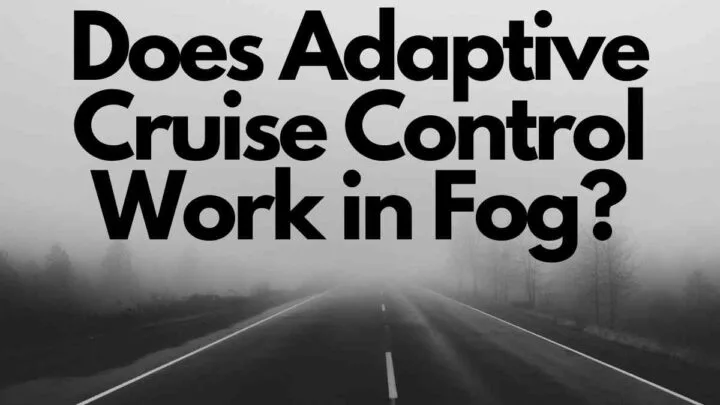Adaptive cruise control is an excellent feature in our cars that improves driver comfort and better road safety.
It uses a combination of sensors and cameras to detect the presence and location of a vehicle or obstacle that’s ahead of you.
However, anything that interferes with the adaptive cruise control signals lowers its accuracy and hence your car’s response.
What about driving with adaptive cruise control in fog? Is it safe?
Adaptive cruise control works in fog but may fail to detect a stationary, slow-moving, or oncoming vehicle in your lane, leading to accidents. While driving in foggy conditions, it’s safe to drive without the adaptive cruise control as then you’ll have better control of your car.
Today’s article looks at adaptive cruise control, why it’s good for you, and why you should avoid it during foggy conditions. Additionally, here’s how you can drive better in foggy conditions on wet and slippery roads. Read on.
How to Drive in Fog
Fog is one primary cause of the accidents and car pile-ups that often occur on roads across the nation. It lowers visibility, sometimes to a quarter a mile or even less.
According to the Federal Highway Administration (FHWA), fog results in an annual 38,700 crashes on average. The crashes result in a yearly average of 600 deaths and 16,300 injuries.
That’s a scary statistic that ought to be limited or eliminated.
Furthermore, fog creates optical illusions causing you to misjudge how far or close a lead car or obstacle is while on the road. If the fog is too dense, it’s better if you avoid driving on the road altogether.
However, if you must drive, here are a few tips to aid you in reaching your destination safely.

Avoid Adaptive Cruise Control/ Cruise Control Systems
Never use cruise control in wet, icy, or foggy road conditions.
Adaptive Cruise Control on Wet Roads
When foggy, the chances are that the road is wet, and cars usually tend to hydroplane or glide over planes of water, especially when you’re traveling at high speeds.
If your car wheels lose contact with the road surface, your car will lose control as it will still be traveling at the set speed.
Wet roads affect the tires’ grip, and once a vehicle becomes unstable and unpredictable, it isn’t easy to correct it.
Adaptive Cruise Control in Foggy Conditions
Apart from the road being wet, dense fog can significantly reduce a driver’s visibility. Some cruise control systems such as the radar adaptive cruise control may still detect a vehicle ahead, but their accuracy is substantially low.
Furthermore, all cruise control systems may or may not inform you of a stationary car that’s in your lane.
Now, if you’re traveling at high speed, the chances are that you’ll accidentally ram into a vehicle or obstacle. Another driver, using the cruise control feature or not, will also fail to spot your stationary car and will ram into you, leading to a pileup.
Go Slow
If you must hit the road, drive at a speed that enables you to control your vehicle or see obstacles on the road.
Some accidents occur when drivers suddenly notice an obstacle or crossing animal in their lane and decide to swerve to avoid hitting it.
In foggy conditions, wet roads don’t provide similar traction as dry road surfaces do. Your vehicle will then skid out of control when you slam the brakes; it’s even worse if you have your cruise control active.
Maintain a Safe Distance With the Car Ahead
Lead cars can at times save your life if you’re smart enough. If it’s moving at a speed that’s too high for you, it’s safe to let it go. However, if the car moves at a comfortable pace, maintain a safe distance.
Depending on the foggy conditions, a gap of 5 to 10 seconds behind the vehicle ahead is okay.
You shouldn’t follow a lead car by using its backlights as your guide. Such a practice makes you lose concentration on whatever is happening around you.
If the lead car’s driver makes a mistake, you’re very much likely to make a similar error in judgment.
Observe a Reasonable Driving Speed Limit
Most roads don’t have speed limits for particular roads or weather conditions. Regardless, visibility and driving speed will affect your reaction and recognition time.
Therefore, drive at a speed limit of 13 miles per hour if the visibility is less than approximately 35 meters. Similarly, drive at a speed limit of 20 miles per hour in a 35 to 60 meters visibility zone.
If visibility is more than 140 meters, it’s safe to travel at speeds of close to 37 miles per hour.
However, the above speed limits are generalized and may not suit your vehicle. Drive at a slower speed if your car has worn-out tires or is challenging to control in foggy and wet conditions.
Don’t Stop in the Middle of the Road
Stopping in the middle of the road, either due to mechanical issues or low visibility, is the single most dangerous mistake you can make on a foggy day.
If you must stop, ensure that you’ve pulled aside and your vehicle is entirely off the road.
Additionally, keep your car lights on to notify other drivers of a stationary car.
Use Fog Lights or Low Beams
If you plan to use high beams to improve your visibility in foggy conditions, you should stop. Water droplets float in the air causing massive glares in fog, leading to a reduction in your visibility.
Use low beams instead of fog lights if your car has them. They’re suited to work better in low visibility zones.
Can You Use Adaptive Cruise Control in Fog if Your Car Has Traction Control?
Modern cars have traction control systems that aid the driver regain control of the vehicle if it starts skidding.
Upon detecting a wheel’s loss of traction, the traction control systems will apply brakes to the individual wheel or cut off engine power to the wheel.
If so, some may presume that it’s safe to drive a car in foggy weather if a vehicle has traction control and adaptive cruise control systems. Well, it’s safer to turn on your traction control system but avoid the adaptive cruise control.
Driving in foggy conditions is more of a visibility issue than a traction one. Be smart, and avoid the adaptive cruise control even if your car has other safety features that complement the system.
Conclusion
Adaptive cruise control works in fog but will endanger your life and that of other road users. Some drivers tend to use the adaptive cruise control as they deem it better and safer driving.
They claim that setting a car to a comfortable and safe speed so that you can only focus on the brakes is safer.
You can, but it’s dangerous. Your adaptive cruise control won’t stop your vehicle simply because you’ve lost traction. Slamming the brakes may make it even worse. More so, you might end up zoning out if you’re not fully attentive and in control of your car.
So, no matter your driving skill or road conditions, I’d recommend turning off your cruise control feature on foggy days.
